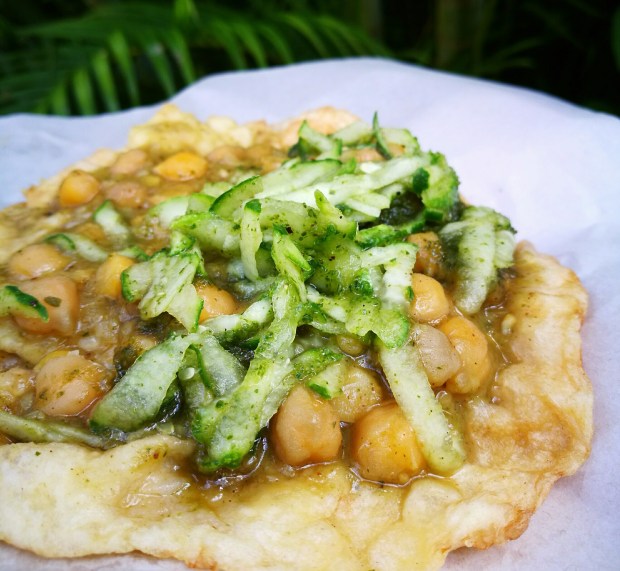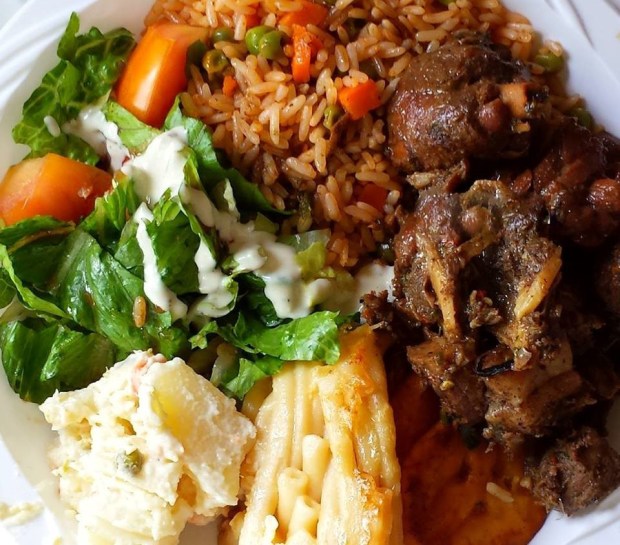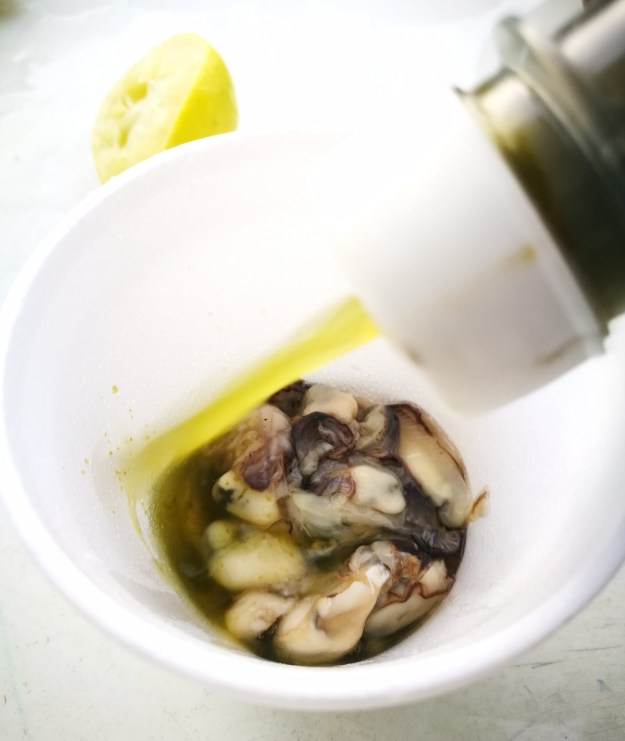Our Trinidadian culinary story is about always wanting more. After centuries of having less than we deserved, we look for more flavor, intensity, salt, and, invariably, much more hot pepper. We don’t like simple food—it feels like something is missing. In our defense, deprivation forced the creativity of our national culinary canon. Slaves and indentured workers didn’t have much say in their daily menu, so they reinterpreted the flavors of their homes as best they could in the New World.
Our ancestors came from places known for rich foods: the Africans and Indians who came to work the sugar and cocoa plantations, the Spanish and French who wanted the work done. (Best to leave the English out of this, as we were mercifully spared much influence from their cuisine.) Smaller batches of Chinese, Syrians, and Portuguese came. It seems that if you were forced or determined to make this place your home, Trinidad and Tobago was only going to accept a certain sort—the sort with an impeccable culinary lineage.
Here, a long weekend’s worth of food. And because I couldn’t help myself, enough suggestions to keep you eating almost too well for several more weeks. Trust that everyone you meet will ply you with suggestions, too. Nay, they will insist. You should listen.
Day 1
Breakfast: doubles.

Best to get doubles dealt with first because it’s what everyone is going to ask if you’ve tried. Every doubles vendor is someone’s favorite. Try one, try many, try the place no one has suggested. The lightly curried chickpeas sandwiched between two palm-sized flatbreads should run for political office—it’s one of the few things respected by all. It will be offered with chutneys of mango, pommecythere (a sour fruit resembling a mango-plum hybrid), coconut, and tamarind as well as sauces of garlic and chadon beni and one mysteriously referred to only as “sweet sauce.” And slight, medium, or hot-pepper sauce.
Lunch: stewed anything and macaroni pie.
Chicken, beef, pork, fish, oxtail—if it was once an animal, it gets caramelized in brown sugar. The flavor bed of almost everything is green seasoning: a bouquet garni of chive, thyme, garlic, chadon beni, and pimento peppers. About the pie: you’ve never met macaroni like this. Here it has become passionately involved with cheese and milk and baked until the top ripples gold and brown.

Dinner: gyros.
The Syrian and Lebanese communities have been here a long time, but street gyros are relatively recent. You’ve eaten some heavy things today, so go gently into dinner. Head to Ariapita Avenue in Woodbrook, a busy area on the hem of Port of Spain proper. The gyro has not yet had a chance to shape-shift like most of our foods. Get it while it still looks familiar.
Day 2

Breakfast: sada roti, or bake and many things.
Sada roti is a lot like pita bread. “Bake” is a bread that defies the obviousness of its name. There is baked bake, fried bake, roasted bake. There is bake flavored with coconut. Fill it with chokas, made from tomato, potato, eggplant, pumpkin, or other inhabitants of the plant kingdom. Seasoned and sauteed until mushy, these are beloved fillings.
Lunch: shark and bake.
It’s been hailed by, um, some other traveling food ambassador as one of the best sandwiches in the world. This is why you agree to come to Maracas Bay. Fillets of shark are deep-fried and served in a bake so light it’s also known as “float.” We’re obsessed with condiments; add to that an embarrassment of toppings. This is not a purist experience. All of those fresh salad veggies and the earlier array encountered at the doubles place are not going to eat themselves. Pile them on.
But know that this meal is so popular that it’s responsible for terrible shark depletion, so do consider other options, like kingfish or shrimp. There’s also a national movement promoting the lionfish as an alternative.

Dinner: barbecue.
The local version is more tart and less cloying than its foreign relatives. I strongly recommend a trip to the outdoor food strip at the Queen’s Park Savannah. Not only is there a lot of good grilled fare, but it’s also a good chance to scope out future meals.
Day 3
Breakfast: eggs, cereal, sausages, pancakes, fruit.
The standard breakfast foods are around. Try the local yogurt. There’s the lovely one made by monks that’s available at the supermarket. Other versions are handmade by secular folk who are keen on exotic flavors. If you’re in Tobago already, the Orange Hill brand is a life-changing experience.
Lunch: crab and dumplings.
Let’s go to—or stay in—Tobago. Today is your day to go to Store Bay, where an array of vendors selling the same things are lined up. Look for the one who just took the curried crab off the fire. The curry is dense. Eat it by alternately chewing and slurping. The dumpling sticks to the theme of muchness. Use it to soak up sauce.
Dinner: seafood or pork.
I really hope that your stay in Tobago fell on a Sunday. Sunday equals Sunday School, a secular street party with a clever name. You’ll find grilled lobster, fish, shrimp, and all you dream of in the Caribbean. Get a new dream: Go straight to a friendly-looking person and ask for the Dragon. He raises pigs himself and feeds them watermelon. This will be the best grilled pork you or anyone has ever had.
Day 4
Breakfast: skip the traditional in favor of sweet snacks.
Take the North Coast Road toward Maracas for smaller, more beautiful bays that remind you that Trinidad is half Caribbean, half South American. Stop at a lookout full of food vendors. Here are the sweetest and the sourest snacks—fruit or vegetables swimming in a bath of sharp seasonings to create tart chows. For the sweet, look for squares or blobs of fruit and nuts that have been baked or fried in sugar. Try sugar cake or chip chip.

Lunch: Chinese food.
Ask Trinidad and Tobago’s diaspora what they miss about home and Chinese food always makes the list. We are devoted to Cantonese things we can’t pronounce, from food trucks to upper-tier restaurants. Our version is heartier and more full-bodied than its pale, airy relatives in other parts of the world.
There’s no Chinatown. There doesn’t need to be—it’s everywhere. The East-West Corridor refers to the most densely populated part of Trinidad. For miles and miles, once there is a town in sight, you’ll see a restaurant or 10. But how? A census conducted within this decade thinks 0.3 percent of the population is Chinese. Did China give us more food than people?
There is one dark side to this. You’ll see ketchup being applied to fried rice. If the cooks put it on the counter, you have no right to judge. They long ago accepted this country’s obsession with ketchup.
We’ve come to the end of the formal tour and the things you didn’t know you wanted. For the rest of your time here, consider:
Roti: folded flatbread sandwich full of curried meat and vegetables. I may be exiled for not putting it at the start of this article. Please go to St. James for this. Please.
Pelau: We have rice. Ergo we have a one-pot rice, meat, and other things dish. Imagine the ingredients all stewed together, infusing each other with their flavors.


Oysters: Not on a half shell over ice. We’re so blasé about the richness of our food that we do oyster shots: half a dozen in a glass with a cocktail sauce served off an old table.
Indian snacks: Head to Central Trinidad—in particular, the town of Debe—for savories and sweets. Look for saheena, baiganee (deep-fried spinach and eggplant), and, of course, more doubles.
Pastelles: This used to be a Christmas food, but now it’s always available. Minced meat seasoned with raisins, olives, and capers is snuggled in a cornmeal bed and wrapped in a banana leaf and steamed. Thank me later.

There’s so much more to say about the scale that slides from idiosyncratic to plain weird, but attention spans are real. Three things to see you safely on your way:
- By “Indian” we mean inspired by the memory of the subcontinent. It’s not what Madhur Jaffrey writes about.
- “African” and “Creole” have become nearly interchangeable. There’s very little authentic African food. Creole food is the transubstantiation of humble things like roots and tubers, salted meats, and piggly castoffs into things that sing the songs of sumptuous goodness.
- I really can’t overstate this: Be careful with the pepper sauce. Whatever you think you can handle, remember the great and terrible Moruga Scorpion pepper was born here.
All photos by TriniChow.